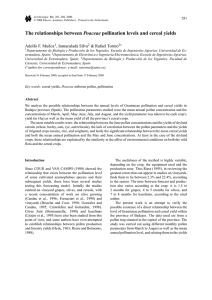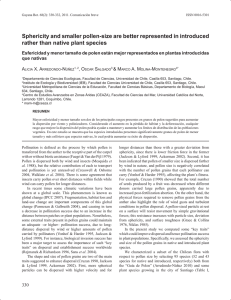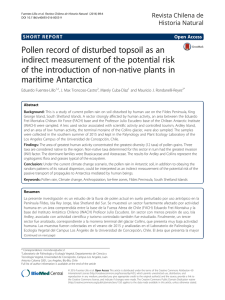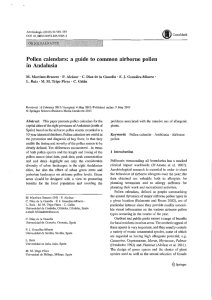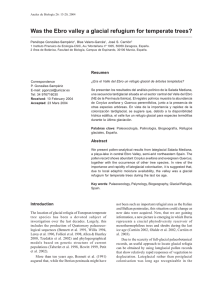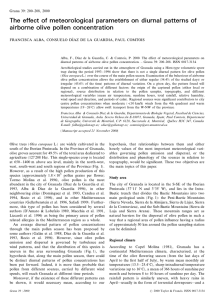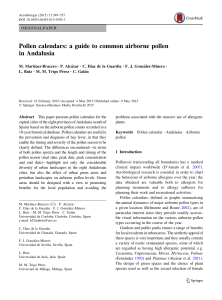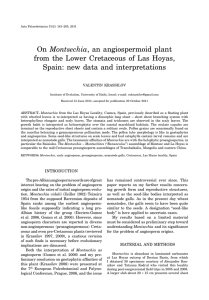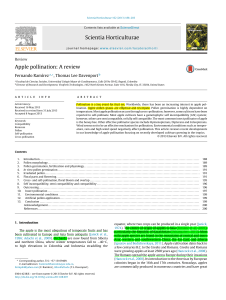Associations Among Pollen Sensitizations From Different Botanical
Anuncio
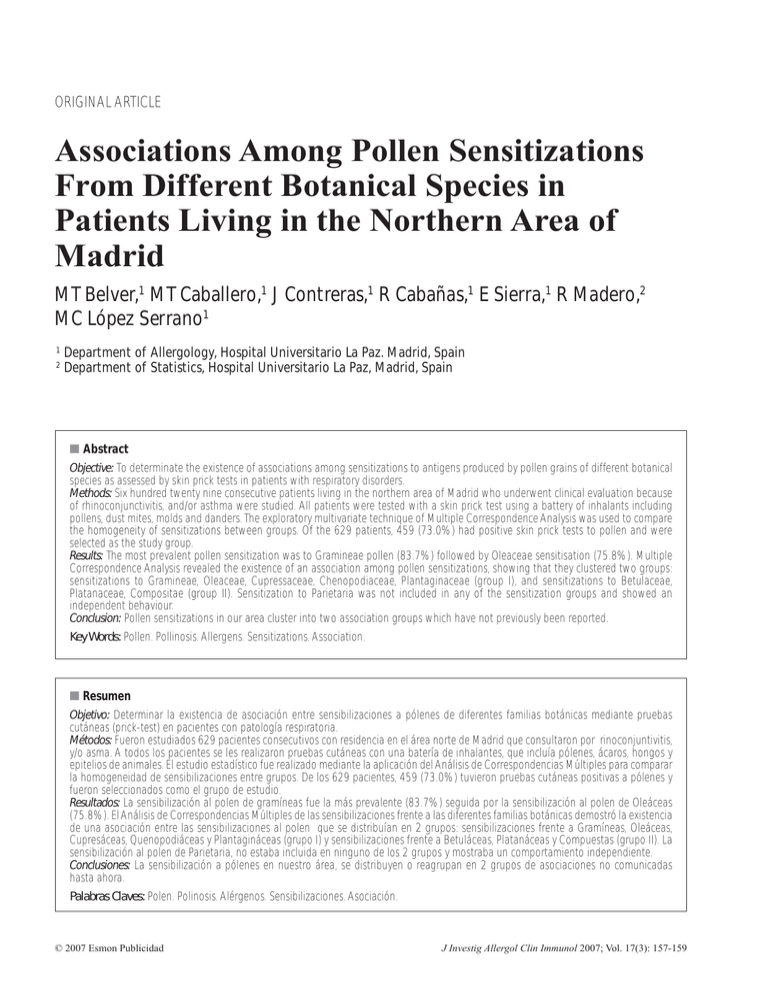
Associations Among Pollen Sensitizations ORIGINAL ARTICLE Associations Among Pollen Sensitizations From Different Botanical Species in Patients Living in the Northern Area of Madrid MT Belver,1 MT Caballero,1 J Contreras,1 R Cabañas,1 E Sierra,1 R Madero,2 MC López Serrano1 1 2 Department of Allergology, Hospital Universitario La Paz. Madrid, Spain Department of Statistics, Hospital Universitario La Paz, Madrid, Spain ■ Abstract Objective: To determinate the existence of associations among sensitizations to antigens produced by pollen grains of different botanical species as assessed by skin prick tests in patients with respiratory disorders. Methods: Six hundred twenty nine consecutive patients living in the northern area of Madrid who underwent clinical evaluation because of rhinoconjunctivitis, and/or asthma were studied. All patients were tested with a skin prick test using a battery of inhalants including pollens, dust mites, molds and danders. The exploratory multivariate technique of Multiple Correspondence Analysis was used to compare the homogeneity of sensitizations between groups. Of the 629 patients, 459 (73.0%) had positive skin prick tests to pollen and were selected as the study group. Results: The most prevalent pollen sensitization was to Gramineae pollen (83.7%) followed by Oleaceae sensitisation (75.8%). Multiple Correspondence Analysis revealed the existence of an association among pollen sensitizations, showing that they clustered two groups: sensitizations to Gramineae, Oleaceae, Cupressaceae, Chenopodiaceae, Plantaginaceae (group I), and sensitizations to Betulaceae, Platanaceae, Compositae (group II). Sensitization to Parietaria was not included in any of the sensitization groups and showed an independent behaviour. Conclusion: Pollen sensitizations in our area cluster into two association groups which have not previously been reported. Key Words: Pollen. Pollinosis. Allergens. Sensitizations. Association. ■ Resumen Objetivo: Determinar la existencia de asociación entre sensibilizaciones a pólenes de diferentes familias botánicas mediante pruebas cutáneas (prick-test) en pacientes con patología respiratoria. Métodos: Fueron estudiados 629 pacientes consecutivos con residencia en el área norte de Madrid que consultaron por rinoconjuntivitis, y/o asma. A todos los pacientes se les realizaron pruebas cutáneas con una batería de inhalantes, que incluía pólenes, ácaros, hongos y epitelios de animales. El estudio estadístico fue realizado mediante la aplicación del Análisis de Correspondencias Múltiples para comparar la homogeneidad de sensibilizaciones entre grupos. De los 629 pacientes, 459 (73.0%) tuvieron pruebas cutáneas positivas a pólenes y fueron seleccionados como el grupo de estudio. Resultados: La sensibilización al polen de gramíneas fue la más prevalente (83.7%) seguida por la sensibilización al polen de Oleáceas (75.8%). El Análisis de Correspondencias Múltiples de las sensibilizaciones frente a las diferentes familias botánicas demostró la existencia de una asociación entre las sensibilizaciones al polen que se distribuían en 2 grupos: sensibilizaciones frente a Gramíneas, Oleáceas, Cupresáceas, Quenopodiáceas y Plantagináceas (grupo I) y sensibilizaciones frente a Betuláceas, Platanáceas y Compuestas (grupo II). La sensibilización al polen de Parietaria, no estaba incluida en ninguno de los 2 grupos y mostraba un comportamiento independiente. Conclusiones: La sensibilización a pólenes en nuestro área, se distribuyen o reagrupan en 2 grupos de asociaciones no comunicadas hasta ahora. Palabras Claves: Polen. Polinosis. Alérgenos. Sensibilizaciones. Asociación. © 2007 Esmon Publicidad J Investig Allergol Clin Immunol 2007; Vol. 17(3): 157-159 158 MT Belver, et al Introduction The prevalence of allergic diseases, mainly pollinosis, has increased in recent decades. Grass pollen is the most important cause in southern Europe, particularly in Italy and Spain [1,2]. The most important pollen grains producing pollinosis in different geographical areas of Spain, are grasses in the centre and north of the peninsula, olive trees in the south (Andalucia) and Parietaria pollen on the Mediterranean coast. [3,4] In our daily clinical practice, we observed that sensitizations to pollens from different botanical families tended to be associated. The aim of our study was to confirm the existence in atopic patients of associations among sensitizations to pollens of different botanical families assessed by skin prick tests. Table 1. Epidemiological and Allergological Characteristics of Study Patients.* Patients ( n = 459) Sex Age, y† Results The demographic and epidemiological characteristics of the patients studied are summarized in Table 1. Of the 629 patients, 459 gave positive skin prick test results to at least one pollen. No statistical differences were found with respect to gender, habitat (rural or urban) and, age between group A and B. Sensitizations to the different botanical families were as follows: 384 patients (83.7%) were sensitized to grass pollen (Gramineae family), 348 patients (75.8%) to the Oleaceae family, 249 patients (54.2%) to the Plantaginaceae family, 211 patients (46.0%) to the Chenopodiaceae family, 153 patients (33.3%) to the Cupressaceae family, 94 patients (20.5%) to the Platanaceae family, 94 patients (20.5%) to the Compositae family (mugwort pollen), 80 patients (17.4%) to the Betulaceae family and 27 patients (5.9%) to Urticaceae pollen. J Investig Allergol Clin Immunol 2007; Vol. 17(3): 157-159 189 (41.2%) 270 (58.8%) 26.1+13.3 (3-71) Habitat Rural Urban 135 (70.6%) 324 (29.4%) Symptoms RC A Both 231 (50.3%) 9 ( 2.0%) 219 (47.7%) Material and Methods A total of 629 consecutive patients, 377 women and 252 men, underwent evaluation at our outpatient Allergy department (CEP José Marvá. Area 5, Madrid). To be included in the study patients had to be living in the 5th Sanitary Area (northern Madrid) and be consulting because of a respiratory disorder: rhinoconjunctivitis and / or asthma. A detailed allergic history was recorded. All patients were tested with the prick test using commercial extracts from a battery of inhalants including pollens, dust mites, molds and danders (ALK-ABELLÓ, Madrid, Spain). Skin prick tests were performed in accordance with the subcommittee on skin tests of the European Academy of Allergology and Clinical Immunology [5]. Quantitative data are described using the mean, median and standard deviation (minimum-maximum) and qualitative data using counts and percentages. Quantitative data were tested by the Mann-Whitney test and qualitative data by the Fisher exact test. The exploratory multivariate technique of Multiple Correspondence Analysis (HOMALS, SPSS) was used for comparing the homogeneity of sensitizations between groups. Two-sided tests were used and a P value less than .05 was considered statistically significant. Statistical analysis was performed with the SPSS for Windows system (Release 9.0) Male Female *Values are number (percentage) unless otherwise indicated. † mean ± SD (range). RC indicates rhinoconjunctivitis; A, asthma. Multiple Correspondence Analysis proved the existence of associations among pollen sensitizations, showing that they clustered into two groups: Group I which included Gramineae, Oleaceae, Cupressaceae, Chenopodiaceae and Plantaginaceae and Group II, which included Betulaceae, Platanaceae, and Compositae (mugwort) (figure). Sensitization to Parietaria was not included in any of the other sensitization groups and showed an independent behaviour. Discussion In our study, rhinoconjunctivitis was the most prevalent pathology in pollen-sensitized patients. This result concurs with those of studies carried out in Europe [6,7] and also in Spain [8]. The most prevalent pollen sensitization found in our study was to Gramineae pollen (83.7 %) followed by Oleaceae sensitization (75.8%). This fact also coincides with the results obtained from the ALERGOLOGICA study [8]. In this paper we described two groups of association patterns among pollen sensitizations. Despite a detailed bibliographic search into this issue (Medline, EMBASE) we found no research or review articles reporting this kind of association among sensitization to pollens from different botanical families. Furthermore, the two association groups among pollen sensitizations found in our study are not related to the different frequencies of sensitizations corresponding to different pollen levels in the Madrid environment. Pollens of the association Group I (Gramineae, Oleaceae, Cupressaceae, Chenopodiaceae and Plantaginaceae) do not coincide with those collected in largest numbers in the Madrid atmosphere, since the total annual pollen grain count is highest for grasses, followed by Cupressaceae, Platanus, Olea Europea and Plantago [9,10]. Thus, this previously unreported association pattern found in our study could be due to sensitization to common allergens present in pollens of different botanical families. © 2007 Esmon Publicidad Associations Among Pollen Sensitizations 3.0 3.0 URTIC URTIC 2.5 2.5 2.0 2.0 Dimension 2 1.5 1.5 1.0 1.0 BETUL BETUL PLATAN PLATAN ARTEM ARTEM .5 0.5 0.0 0.0 PLANTAG PLANTAG OLEA OLEA CHENO CHENO GRAMI GRAMI CUPRES CUPRES -.5 -0.5 -1.0-1.0 -2,5 -2.5 -2.0 -2.0 -1.5 -1.5 -1.0 -1.0 -0.5 -.5 0.0 0.0 0.5 .5 1.0 1.0 Dimension 1 Figure 1. Category quantification (HOMALS).* *Homogeneity analysis (Multiple Correspondence Analysis) of the patterns of sensitization to the 9 pollen families studied. Positive categories (sensitization to each pollen family) are represented on the left of the figure and negative categories (no sensitizations) on the right. Betul indicates Betulaceae; Platan, Platanaceae; Artem, Artemisia (Compositae); Plantag, Plantaginaceae; Cheno, Chenopodiaceae; Olea, Oleaceae;Grami, Graminae; Cupres, Cupressaceae. References 1. Andersson K, Lidholm J. Characteristics and Immunobiology of Grass Pollen Allergens. Int Arch Allergy Immunol. 2003;130:87107. 2. Caballero T, Martín Esteban M. Association between pollen hypersensitivity and edible vegetable allergy: A review. J Investig Allergol Clin Immunol.1998;8 (1):6-16. 3. Subiza Garrido-Lestache J. “Allergenic pollens in Spain”. Allergol Immunopathol. (Madr) 2004;32 (3):121-4. © 2007 Esmon Publicidad 159 4. Subiza J, FeoBrito F, Pola J, Moral A, Fernández J, Jeréz M, Ferreiro M. Pólenes alergénicos y polinosis en 12 ciudades españolas. Rev.Esp.Alergol.Inmunol. Clin. 1998;13:45-58. 5. Dreborg S. Skin tests used in type I allergy testing. Position Paper. Allergy. 1989;44 Suppl. 10:38-48. The Subcommittee on Aerobiology and Enviroment Aspects of Inhalant Allergens of the European Academy of Allergology and Clinical Immunology. 6. Variations in the prevalence of respiratory symptoms, selfreported asthma attacks, and use of asthma medication in the European Community Respiratory Health Survey” (ECRHS). European Respiratory Journal. 1996;9:687-95. 7. European Allergy White Paper. Allergic diseases as a Public Health problem. The UCB Institute of Allergy 1997. Chapter 1. 8. ALERGOLOGICA: Factores Epidemiológicos, Clínicos y Socioeconómicos de las Enfermedades Alérgicas en España. SEIAC y Alergología e Inmunología. Abelló S.A. Capítulos: 3, 4, 13. Madrid: Nilo Industria Gráfica; 1995. 9. Subiza J, Jeréz M, Jimenéz JA, Narganes MJ, Cabrera M, Varela S, Subiza E. Allergenic Pollen and Pollinosis in Madrid. J. Allergy Clin Immunol. 1995;96:15-26. 10. Caballero T, Romualdo L,Crespo JF, Pascual C, Muñóz-Pereira M, Martín- Esteban M. Cupressaceae pollinosis in the Madrid area. Clin Exp Allergy. 1996;26:197-201. ❚ Manuscript submitted December 2, 2006; accepted January 17, 2007. ❚ Mª Teresa Belver Consultas Externas de Alergia Allergy Department Hospital Universitario “ La Paz” Pº de la Castellana 261 28046 Madrid- [email protected] Telephone number: 91-7277144 Fax number: 91-7277050 J Investig Allergol Clin Immunol 2007; Vol. 17(3): 157-159

